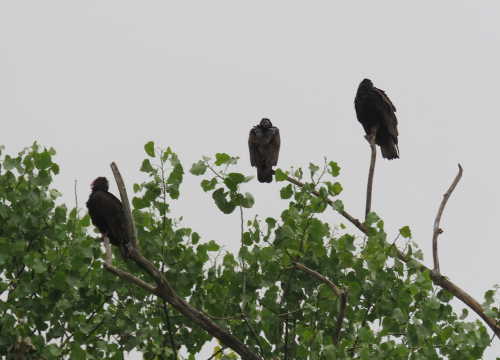
LAKE COUNTY, Calif. – Turkey vultures are knocked for their vulgar habits which, let's face it, keep our roads and valleys neat and clean – even keeping disease at bay.
But these carrion-eating birds who excrete on themselves to keep cool, regurgitate and “dive” head first into their dead prey do possess bizarre table manners to say the least!
The vulture's scientific name, Cathartes aura, is derived from the Greek word “katharsis,” which means to wash or purge.
The adult turkey vulture's red, nearly naked head allows it to keep itself clean after it feeds on carrion.
These impressive-looking birds are included in the few species of birds that possess a sense of smell.
Their highly developed sense of smell alerts them to decaying, dead animals, so they usually do not find it necessary to make a kill.
These scavengers do, at times consume the odd plant or insect.
Ornithologists have determined that the portion of the brain that processes smell in a turkey vulture is much larger when compared to birds of comparable size.
Scientists have also determined that as the turkey vultures soar, which they are able to do at quite low altitudes, they pick up odors of carrion. Conversely, these interesting birds may also soar at heights up to four miles.

When you see a number of vultures circling, that is called a “kettle,” as they appear to be boiling up out of the landscape.
These enormous birds often achieve a 6-foot wingspan, and are quite graceful when viewed soaring on the thermals – those layers of heated air above.
Many birders refer to turkey vultures as TVs, and they are also called turkey buzzard or plain “buzzard.”
Since their silhouettes form a “V” while in flight they are easy to discern – “V” for vulture.
Turkey vultures have been noted to nest in burned-out or hollow tree stumps. Their breeding season here is in the summer months.
If you happen to note vultures hopping, you are witnessing their special courtship practice. Then, several birds will make a circle, and, wings partially extended, they will hop about the circle and begin to follow one another.
They may nest in one of many protected sites, such as a cave, crevice or even in understory, with nests of scant construction.
Kathleen Scavone, M.A., is a retired educator, potter, writer and author of “Anderson Marsh State Historic Park: A Walking History, Prehistory, Flora, and Fauna Tour of a California State Park” and “Native Americans of Lake County.” She also formerly wrote for NASA and JPL as one of their “Solar System Ambassadors.” She was selected “Lake County Teacher of the Year, 1998-99” by the Lake County Office of Education, and chosen as one of 10 state finalists the same year by the California Department of Education.

 How to resolve AdBlock issue?
How to resolve AdBlock issue? 



